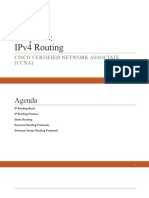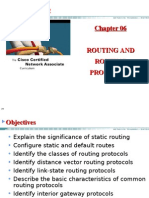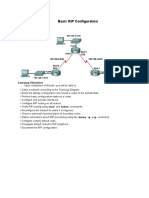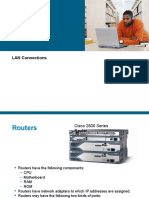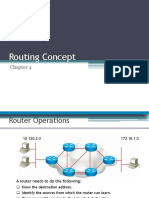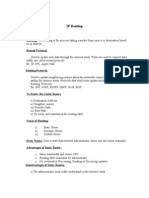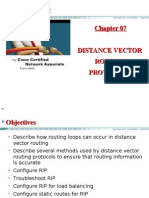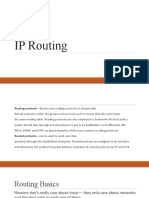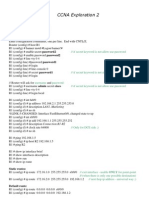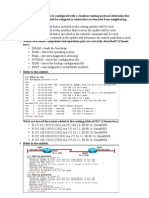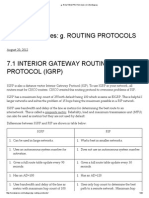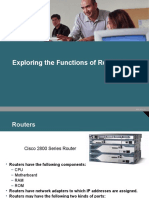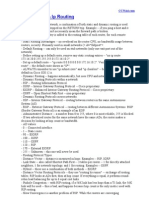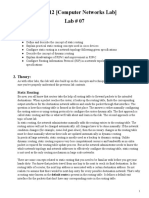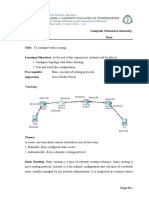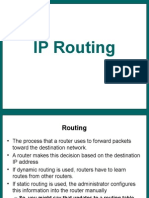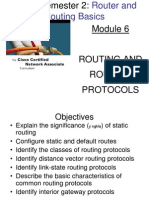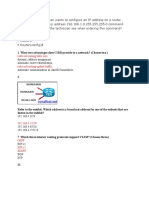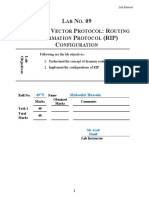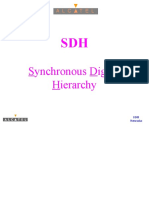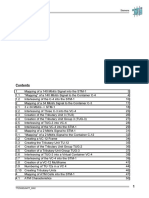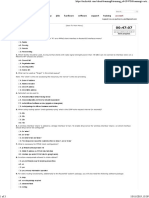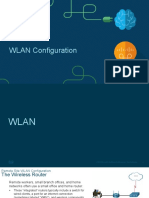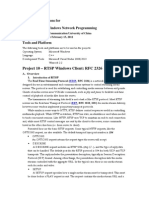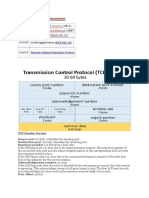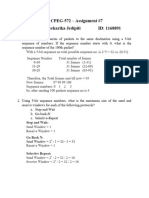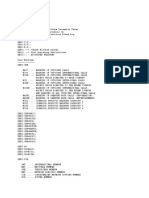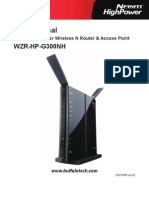Routing: Eng - Ahmed Nabil
Routing: Eng - Ahmed Nabil
Uploaded by
hooda3Copyright:
Available Formats
Routing: Eng - Ahmed Nabil
Routing: Eng - Ahmed Nabil
Uploaded by
hooda3Original Description:
Original Title
Copyright
Available Formats
Share this document
Did you find this document useful?
Is this content inappropriate?
Copyright:
Available Formats
Routing: Eng - Ahmed Nabil
Routing: Eng - Ahmed Nabil
Uploaded by
hooda3Copyright:
Available Formats
Routing [CCNA 200-120]
1 | P a g e
CCNA 200-120
Routing
Arafat Mohamed
Special thanks to Eng.Ahmed Nabil
References
How to Master CCNA 2013
Cisco 200-120 Guide
Routing [CCNA 200-120]
2 | P a g e
Routing
Routing: means taking a packet from one device and sending it through the network to
another device on a different network.
Path determination: refers to the work done by routing protocols to learn all possible routes,
and choose the best route.
A routing protocol: used between routers to exchange routing information and build the
routing table.
Routed protocols: the protocols that we are routing, for example IPv4 or IPv6.
To be able to route packets, a router must know, at a minimum, the following:
Destination address
Neighbour routers from which it can learn about remote networks
Possible routes to all remote networks
The best route to each remote network
How to maintain and verify routing information
Routing Operation:
If a network is directly connected, then the router already knows how to get to it.
If a network isnt directly connected to the router, the router must use one of two ways to
learn how to get to the remote network:
Static routing: meaning that someone must hand-type all network locations into the routing
table. If a change occurs in the network, the administrator is responsible for updating all
changes by hand into all routers.
Dynamic routing: a protocol on one router communicates with the same protocol running on
neighbor routers.
The routers then update each other about all the networks they know about and place this
information into the routing table.
If a change occurs in the network, the dynamic routing protocols automatically inform all
routers about the event.
Learning:
1. The router learns about remote networks from neighbor routers or from an
administrator.
2. The router then builds a routing table that describes how to find the remote networks.
Forwarding:
Use a routing table to learn where to forward IP packets:
1. Known: the router will forward the packet to the destination.
2. Unknown: the router will discard the packet and send an ICMP destination unreachable
message back out interface.
3. Broadcast: the router will take packet to itself.
Routing [CCNA 200-120]
3 | P a g e
Notes:
The Administrative distance is the trustworthiness of a route (0 is best, 255 is worst).
Your firewall might be blocking ICMP traffic.
Traceroute uses the ICMP protocol.
You must be able to ping the router interface before you add the route.
Routing [CCNA 200-120]
4 | P a g e
Static Routing (S)
Static routing has the following benefits:
No overhead on the router CPU.
No bandwidth usage between routers.
It adds security .
Notes:
Administrative distance: By default 1, (0 if you use an exit interface).
You can change the default value by adding an administrative at the end of the
command.
We use default routing to send packets with a remote destination network not in the
routing table to the next-hop router.
To be on the safe side, you should always turn on the ip classless command when you
use default routing.
Configuration:
Static route (S):
R1(config)# ip route destination network subnet mask next hop ip Admin Distance = 1
R1(config)# ip route destination network subnet mask interface Admin Distance = 0
Default route (S*):
R1(config)# ip route 0.0.0.0 0.0.0.0 next hop ip
R1(config)# ip route 0.0.0.0 0.0.0.0 interface
To configure your router in classful mode:
R1(config)# no ip classless
To configure your router in classless mode:
R1(config)# ip classless
Configuring a gateway of last resort :
Gateway(config)#ip route 0.0.0.0 0.0.0.0 x.x.x.x
Gateway(config)#ip route 0.0.0.0 0.0.0.0 interface
Gateway(config)#ip default-network x.x.x.x
To clear all routes:
Router# clear ip route *
Show commands:
Router#show ip route
Router#show ip route static
Routing [CCNA 200-120]
5 | P a g e
Dynamic routing
Autonomous system is a collection of routers/networks that belongs to a single administrative
domain. 0 65535
Within an autonomous system we run a routing protocol and we call these interior gateway
protocols (IGP).
Between autonomous systems we also run a routing protocol but we call these external
gateway protocols (EGP).
There is only one routing protocol we use on the internet which is called BGP (Border
Gateway Protocol).
The lower the administrative distance the better.
Protocol Admin distance
Direct connected 0
Static 1
BGB 20
EIGRP 90
IGRP 100
OSPF 110
ISIS 115
RIP 120
Interior routing protocols are divided in three different classes:
Distance Vector (RIP)
Hybrid or Advanced Distance Vector (EIGRP)
Link-State (OSPF)
Routing protocols can be classfull or classless:
Classfull routing protocols DO NOT send the subnet mask with their updates.
Classless routing protocols send the subnet mask with their updates.
Routing [CCNA 200-120]
6 | P a g e
Distance Vector (RIPv1 IGRP)
Distance: How far away.
Vector: Which direction.
Operation:
@ Startup:
Each router will copy its routing table and send it periodically on 255.255.255.255.
@ Convergence:
Periodic updates every 30 seconds act as keep alive.
Router will delete inactive networks after 6 updates (180 seconds).
@ Change:
Problems:
Slow convergence.
Routing loop.
Solutions:
1. TTL Expire: starts with 255 and when it reaches to (1), the router will discard it.
2. Triggered update + Poisoned route + Poison reverse:
Once a network goes down the router will send a triggered update immediately to
update its neighbours.
Poisoned route: update for this network with an infinite metric (16).
Poison reverse: any router receives triggered update + poison route will forward it and
reply with ACK.
3. Spilt horizon: You dont advertise to your neighbour what you learned from them.
4. Hold down timer: if a route fails, dont accept any updates about that route unless:
- It returned back with the same metric and direction.
- Hold down time expires.
Routing [CCNA 200-120]
7 | P a g e
RIPv2 Configuration (R):
Router(config)#router rip
Router(config-router)#network x.x.x.x
Router(config-router)#version 2
Router(config-router)#no auto-summary
Router(config-router)#passive-interface xxx.
Router(config)#maximum-paths x.
Show commands:
Router#show ip route
Router#show ip route rip
Router#debug ip rip
To know which versions of rip is run use
Router#show ip protocols
Routing [CCNA 200-120]
8 | P a g e
EIGRP Ciscos Hybrid Routing Protocol
Operation:
@ Startup:
Routers will start sending hello packets to other routers on 224.0.0.10.
Neighbours will exchange routing information which will be saved in the topology table.
Selecting the best path based on bandwidth, delay, load, reliability and MTU.
The best path from the topology table will be copied in the routing table.
@ Convergence:
Periodic hello act as keep a live:
1. Fast links (Speed > T1 speed):
Hello interval= 5 seconds.
Dead interval= 15 seconds.
2. Slow links (Speed < T1 speed):
Hello interval= 60 seconds.
Dead interval= 180 seconds.
@ Change:
Send partial triggered update to all neighbours.
Routing [CCNA 200-120]
9 | P a g e
EIGRP Terminology:
EIGRP Neighbor Table:
Lists all directly connected neighbors:
Next Hop Router.
Interface.
EIGRP Topology Table:
Lists all learned routes from all EIGRP neighbors:
Destination.
Metric.
Global Routing Table:
Best routes from EIGRP topology table will be copied to the routing table.
Advertised distance (AD): How far the destination is away for your neighbor.
Feasible distance (FD): The total distance to the destination.
Successor (S): the best path to the destination.
Feasible successor (FS): backup path.
If you lose the successor because of a link failure EIGRP will copy/paste the feasible
successor in the routing table
If you lose the successor and there isnt feasible successor available, EIGRP will queries
neighbours and recalculate successor.
EIGRP metrics:
Bandwidth, Delay, Load, Reliability and MTU.
By default EIGRP only uses bandwidth and delay. Load and reliability are disabled by
default.
EIGRP Authentication:
Only supports MD5.
The Key-chain can be different per router.
The key-ID has to be the same on every router.
Routing [CCNA 200-120]
10 | P a g e
EIGRP Configuration (D):
Router(config)#router eigrp 1
Router(config-router)#no auto-summary
Router(config-router)#network x.x.x.x
Configure authentication:
1. Configure a key-chain:
Router(config)#key chain MYCHAIN
Router(config-keychain)#key 1
Router(config-keychain-key)#key-string BANANA
2. Now we have to activate it:
Router(config)#interface FastEthernet 0/0
Router(config-if)#ip authentication mode eigrp 1 md5
Router(config-if)#ip authentication key-chain eigrp 1 MYCHAIN
To change backup numbers:
Router(config-router)# variance 4
Show commands:
Router#show ip route
Router#show ip route eigrp
Router#show ip protocols
Router#show ip eigrp neighbors
Router#show ip eigrp topology
Router#debug ip eigrp
Routing [CCNA 200-120]
11 | P a g e
OSPF Open Shortest Path First
Link state:
Link: Thats the interface of our router.
State: Description of the interface and how its connected to neighbor routers.
Operation:
@ Startup:
1. Neighbour discovery: send hello packets on 224.0.0.5.
2. Router discovery:
- Exchange of LSAs.
- Build LSDB Link state database .
- Electing DR and BDR .
- Calculating best path using SPF shortest path first algorithm.
@ Convergence:
1. Periodic updates every 30 minutes.
2. Periodic hello every 10 seconds act as keep alive.
@ Change:
1. Router that feels change:
- Rebuild new LSA.
- Send triggered LSA describing new state on 224.0.0.6.
2. Neighbours routers:
- Remove the old LSA.
- Update LSDB with the new LSA.
- Redrawing trees till routing table is updated.
Routing [CCNA 200-120]
12 | P a g e
Hello packet:
Router ID: its 32 bit, the highest IP address on any active interface.
- Loopback interface.
- Physical interface.
Router Priority: used to determine who will become designated or backup designated
router.
Hello Interval: 10 seconds, Dead Interval: 40 seconds.
Area ID: its 32 bit.
Authentication password.
OSPF Topologies:
Point-to-Point.
Multi-Access.
Multi-Access network:
All our OSPF routers will only form full neighbor adjacencies with the DR and BDR on
224.0.0.6 and not with all other routers.
DR (Designated Router):
1. Router that first boots ospf.
2. Router having highest priority:
The default priority is 1.
A priority of 0 means you will never be elected as DR or BDR.
3. Router having highest router id.
4. Dead time = 4 hello = 40 seconds.
DROTHER: a router isnt DR or BDR.
Type of routers:
Backbone routers: routers in the backbone area (area 0).
Area border routers (ABR): routers between 2 areas.
Autonomous system border routers (ASBR).
LSAs Types:
1. LSA Type 1: generated by each router in AS, contains router LSA.
2. LSA Type 2: generated by DR, contains network link LSAs.
3. LSA Type 3: generated by ABR, contains network link summary LSA.
4. LSA Type 4: generated by ABR, contains ASBR summary LSA.
5. LSA Type 5: generated by ASBR, contains AS external link LSA.
Routing [CCNA 200-120]
13 | P a g e
OSPF Metric:
Cost which is based on the bandwidth of an interface.
Cost = Reference Bandwidth / Interface Bandwidth.
The reference bandwidth is a default value on Cisco routers which is a 100Mbit interface.
The lower the cost the better the path is.
OSPF Load balancing:
Paths must have an equal cost.
4 equal cost paths will be placed in routing table.
Maximum of 16 paths.
To make paths equal cost, change the cost of a link
If a path is not equal we can make it so by manually changing the cost or bandwidth of
an interface.
OSPF default route:
You need to use the default-information originate command. If you dont already have a
default route in your routing table then you need to add the always keyword.
To block the hello packets but still advertise the network in OSPF you can use the
passive-interface command on the interface.
Routing [CCNA 200-120]
14 | P a g e
OSPF Configuration (O):
Router(config)#router ospf 1 - process ID
Router(config-router)#network x.x.x.x wildcard mask area 0
Advertise a default route:
Router(config)#router ospf 1
Router(config-router)#default-information originate always symbol O*E2
Plaintext authentication:
Router(config)#interface FastEthernet 1/0
Router(config-if)#ip ospf authentication
Router(config-if)#ip ospf authentication-key secret
MD5 authentication:
Router(config)#interface FastEthernet 1/0
Router(config-if)#ip ospf authentication message-digest
Router(config-if)#ip ospf message-digest-key 1 md5 mykey
Area authentication:
Router(config-if)#router ospf 1
Router(config-router)#area 0 authentication
MD5 authentication:
Router(config-router)#area 0 authentication message-digest
Change the OSPF timers:
Router(config-if)#interface FastEthernet 1/0
Router(config-if)#ip ospf hello-interval 5
Router(config-if)#ip ospf dead-interval 15
Change the priority:
Router(config)#interface FastEthernet 0/0
Router(config-if)#ip ospf priority 200
Change the cost:
Router(config)#interface FastEthernet 1/0
Router(config-if)#ip ospf cost 50
Create a loopback
Router(config)#interface loopback 0
Router(config-if)#ip address 2.2.2.2 255.255.255.0
Reset the OSPF process:
Router#clear ip ospf process
Show commands:
Router#show ip route
Router#show ip route ospf
Router#show ip ospf neighbor
Router#show ip protocols - Check router ID
Router#show ip ospf interface fa1/0 - Check the cost
Routing [CCNA 200-120]
15 | P a g e
RIP v1:
1. Send periodic updates every 30 seconds on 255.255.255.255.
2. Triggered update at change with an infinite metric (16).
3. Equal load balancing, 4 paths by default, 16 or more by configuration.
4. Metric is hop count [maximum 15 hop].
5. Use BellmanFord algorithm to calculate routing table.
6. Classfull.
7. Admin distance 120.
8. Hold down timer 180 seconds.
IGRP:
1. Send periodic updates every 90 seconds on 255.255.255.255.
2. Triggered update at change.
3. Equal & un equal load balancing, 4 paths by default, 16 or more by configuration.
4. Metric is [bandwidth & delay] default + load + reliability + MTU [100 router by
default, 255 by configuration].
5. Use BellmanFord algorithm to calculate routing table.
6. Classfull.
7. Admin distance 100.
8. Hold down timer 280 seconds.
Routing [CCNA 200-120]
16 | P a g e
RIP v2:
1. Send periodic updates every 30 seconds on 224.0.0.9.
2. Triggered update at change with an infinite metric (16).
3. Equal load balancing, 4 paths by default, 16 or more by configuration.
4. Metric is hop count [maximum 15 hop].
5. Use BellmanFord algorithm to calculate routing table.
6. Classless.
7. Admin distance 120.
8. Hold down timer 180 seconds.
9. Support authentication.
EIGRP:
1. Send full routing table at startup.
2. Send periodic hello at convergence act as keep alive on 224.0.0.10.
3. Send partial triggered update at change.
4. Use dual algorithm to calculate best path and backup path.
5. Admin distance: Internal 90 External 170.
6. Support many routed protocols [IPv4 IPv6 IPX Apple Talk].
7. Equal & non-equal load balancing, 4 paths by default, 16 or more by configuration.
8. Classless.
9. Support authentication.
OSPF:
1. Send hello packets at startup on 224.0.0.5.
2. Send triggred LSA at change on 224.0.0.6.
3. Send periodic hello every 10 seconds, periodic LSA every 30 minutes at convergence.
4. Use Dijkstra algorithm to calculate SPF shortest path first.
5. Metric is cost.
6. Admin distance: 110.
7. Equal load balancing, 4 paths by default, 16 or more by configuration.
8. Classless.
9. Support authentication.
10. Support hierarchical design multiple area.
You might also like
- NEC IPASOLINK VR4 Configuration Guide - KSGM ProjectDocument29 pagesNEC IPASOLINK VR4 Configuration Guide - KSGM ProjectRichard Thainkha100% (2)
- Lab Manual For JnciaDocument35 pagesLab Manual For JnciaAmit Kumar Saini100% (1)
- Ccna (Router Configurations)Document159 pagesCcna (Router Configurations)Sudhir MaherwalNo ratings yet
- Static RoutingDocument41 pagesStatic RoutingPharoahNo ratings yet
- Chapter 6 IPv4 RoutingDocument37 pagesChapter 6 IPv4 RoutingnuhonoNo ratings yet
- CCNAv3.3 206Document33 pagesCCNAv3.3 206Tung HoangNo ratings yet
- 016 Enabling RIPDocument20 pages016 Enabling RIPBAHRAIN1967No ratings yet
- Basic RIP Configuration: Topology DiagramDocument6 pagesBasic RIP Configuration: Topology DiagramNader AbdessayedNo ratings yet
- Eigrp and RipDocument5 pagesEigrp and Ripabhineet sharmaNo ratings yet
- 4 Chapter Four - 2Document20 pages4 Chapter Four - 2Habtamu AlemuNo ratings yet
- Lesson 4 - Routing TechnologiesDocument88 pagesLesson 4 - Routing TechnologiesPhan Chi BaoNo ratings yet
- Route NotesDocument17 pagesRoute NotesSDE NIBNo ratings yet
- Routing Rip PDFDocument19 pagesRouting Rip PDFAxel LwiantoroNo ratings yet
- Ccna 200-301 - 2Document52 pagesCcna 200-301 - 2Wahyudi YusufNo ratings yet
- CcnaDocument19 pagesCcnaMavhungu MarvinNo ratings yet
- CCNAv3.3 207Document58 pagesCCNAv3.3 207Tung HoangNo ratings yet
- EXPERIMENT NO.3Document6 pagesEXPERIMENT NO.3Karthik NadarNo ratings yet
- Cours ReseauDocument14 pagesCours ReseauNlend IsraëlNo ratings yet
- NDC Chapter 3Document48 pagesNDC Chapter 3tadessewale39No ratings yet
- IP RoutingDocument11 pagesIP Routingmaria bashirNo ratings yet
- 2.static RoutingDocument34 pages2.static RoutingEdgar Giraldo ArdilaNo ratings yet
- Routing Information Protocol (RIP)Document5 pagesRouting Information Protocol (RIP)Kyawzaw AungNo ratings yet
- What Is Global Configuration Mode Used For?Document10 pagesWhat Is Global Configuration Mode Used For?Abhishek KulkarniNo ratings yet
- Cisco Exploration 2Document8 pagesCisco Exploration 2amjikbookNo ratings yet
- Subnet Mask That Should Be Assigned To Routes That Are Learned From Neighboring Classless Routers?Document16 pagesSubnet Mask That Should Be Assigned To Routes That Are Learned From Neighboring Classless Routers?Kinga JanasińskaNo ratings yet
- G PDFDocument20 pagesG PDFokienaNo ratings yet
- Lecture - 9Document19 pagesLecture - 9amaan44633No ratings yet
- CCNA 2 - Final Exam (A) 100/100: Www.9tut - Info WWW - Ccna4u.tk WWW - Ccnastudy.infoDocument12 pagesCCNA 2 - Final Exam (A) 100/100: Www.9tut - Info WWW - Ccna4u.tk WWW - Ccnastudy.infoBashoor HussainNo ratings yet
- Bsci30s02 EigrpDocument79 pagesBsci30s02 EigrpFabio QuintanaNo ratings yet
- Routing Overview - Static RouteDocument20 pagesRouting Overview - Static RouteĐinh TúNo ratings yet
- Routing Information Protocol (Ripv1 & Ripv2)Document42 pagesRouting Information Protocol (Ripv1 & Ripv2)Sayyeda UmbereenNo ratings yet
- Quick Guide - Ip RoutingDocument3 pagesQuick Guide - Ip RoutingCCNAResourcesNo ratings yet
- Dynamic RoutingDocument9 pagesDynamic Routingi200634 Areeba SattarNo ratings yet
- Network Devices Lecture Week 2: Static RoutingDocument45 pagesNetwork Devices Lecture Week 2: Static RoutingAayush ShahiNo ratings yet
- CSE 4512 Computer Networks-Lab 07Document17 pagesCSE 4512 Computer Networks-Lab 07Ahmad MukaddasNo ratings yet
- CN EXP5 Static RoutingDocument3 pagesCN EXP5 Static Routingshweta joshiNo ratings yet
- Day 9 RoutingDocument23 pagesDay 9 RoutingGorvam SaddarNo ratings yet
- Test Review Ccna2Document48 pagesTest Review Ccna2saanireNo ratings yet
- Static Routing Introduction To Dynamic Routing Protocols RIP v1 and RIP v2, OSPF Eigrp BGPDocument12 pagesStatic Routing Introduction To Dynamic Routing Protocols RIP v1 and RIP v2, OSPF Eigrp BGPShiv Pratap SinghNo ratings yet
- Routing Protocol and Routed Protocol: Lab #5 IP Routing IDocument8 pagesRouting Protocol and Routed Protocol: Lab #5 IP Routing IMahfuzur RahmanNo ratings yet
- Static Routing Introduction To Dynamic Routing Protocols RIP v1 and RIP v2, OSPF Eigrp BGPDocument12 pagesStatic Routing Introduction To Dynamic Routing Protocols RIP v1 and RIP v2, OSPF Eigrp BGPShiv Pratap SinghNo ratings yet
- Static RoutingDocument15 pagesStatic Routingsalah kasliNo ratings yet
- Chapter No 4 Routing Information Protocol: RIP TimersDocument11 pagesChapter No 4 Routing Information Protocol: RIP Timersjohn borusNo ratings yet
- Cnap 2 06 Routing & Routing ProtocolsDocument27 pagesCnap 2 06 Routing & Routing ProtocolsVo Ngoc HoangNo ratings yet
- Prueba LAN CiscoDocument7 pagesPrueba LAN CiscoDario Orosco OrozcoNo ratings yet
- Lab CN Submitted by Mubashir Hussain 4979Document18 pagesLab CN Submitted by Mubashir Hussain 4979Mubashir HussainNo ratings yet
- Static Routing Introduction To Dynamic Routing Protocols RIP v1 and RIP v2, OSPF Eigrp BGPDocument12 pagesStatic Routing Introduction To Dynamic Routing Protocols RIP v1 and RIP v2, OSPF Eigrp BGPelakya rageshNo ratings yet
- Network Layer - Static RoutingDocument38 pagesNetwork Layer - Static RoutingArif ShakilNo ratings yet
- Static Routing: Routing Protocols and ConceptsDocument41 pagesStatic Routing: Routing Protocols and ConceptsAtmanNo ratings yet
- EIGRPDocument102 pagesEIGRPNguyễn Mạnh ThếNo ratings yet
- CN Lecture 8Document35 pagesCN Lecture 8Esraa MahrousNo ratings yet
- CN Lecture 05 Routing RIPDocument23 pagesCN Lecture 05 Routing RIPSuridNo ratings yet
- LAB Static RouteDocument6 pagesLAB Static Routeahmed- OunNo ratings yet
- Lab 7-Static IPv4 and IPv6Document7 pagesLab 7-Static IPv4 and IPv6Kanwar ZainNo ratings yet
- Routing Protocols FundamentalsDocument33 pagesRouting Protocols FundamentalsWilson Patricio EscandonNo ratings yet
- CCNA Exploration2: Routing Protocols and Concepts - Final ExamDocument22 pagesCCNA Exploration2: Routing Protocols and Concepts - Final Examapnea1984No ratings yet
- Class 19 - Dynamic Routing and Routing Ion Protocol (RIP) Friday 16 (1) .11.07Document25 pagesClass 19 - Dynamic Routing and Routing Ion Protocol (RIP) Friday 16 (1) .11.07Vignesh BramNo ratings yet
- Routing Protocols: IGRP: by Carl MarandolaDocument30 pagesRouting Protocols: IGRP: by Carl MarandolaDenny GunawanNo ratings yet
- CN Practical No 9-12Document12 pagesCN Practical No 9-12prabhashankarjha20No ratings yet
- CCNA 2 Final Oct 14th 2009Document29 pagesCCNA 2 Final Oct 14th 2009Enes MorinaNo ratings yet
- CISCO PACKET TRACER LABS: Best practice of configuring or troubleshooting NetworkFrom EverandCISCO PACKET TRACER LABS: Best practice of configuring or troubleshooting NetworkNo ratings yet
- ROUTING INFORMATION PROTOCOL: RIP DYNAMIC ROUTING LAB CONFIGURATIONFrom EverandROUTING INFORMATION PROTOCOL: RIP DYNAMIC ROUTING LAB CONFIGURATIONNo ratings yet
- Synchronous Digital Hierarchy: A L C T E LDocument99 pagesSynchronous Digital Hierarchy: A L C T E Lhooda3No ratings yet
- 04 Tt2500eu04tt 0002 MappingDocument86 pages04 Tt2500eu04tt 0002 Mappinghooda3No ratings yet
- 01 Tt2500eu04tt 0002 PDH MultiplexingDocument30 pages01 Tt2500eu04tt 0002 PDH Multiplexinghooda3No ratings yet
- Dk-Mansurah5 Upgrade 8e1 Dk-Mans-TeraaDocument5 pagesDk-Mansurah5 Upgrade 8e1 Dk-Mans-Teraahooda3No ratings yet
- Introduction To New Functions of 3900 Series Dual-Mode Base Station - 20090223-IsSUE1.0-BDocument31 pagesIntroduction To New Functions of 3900 Series Dual-Mode Base Station - 20090223-IsSUE1.0-Bhooda3No ratings yet
- Introduction To New Functions of 3900 Series Dual-Mode Base Station - 20090223-IsSUE1.0-BDocument31 pagesIntroduction To New Functions of 3900 Series Dual-Mode Base Station - 20090223-IsSUE1.0-Bhooda3No ratings yet
- Odoo in High Availability and Ready For Mass Scalability With Zevenet - ZEVENETDocument10 pagesOdoo in High Availability and Ready For Mass Scalability With Zevenet - ZEVENETIdris IdrisNo ratings yet
- BITS Pilani: M1.4V2 Physical & Link LayersDocument9 pagesBITS Pilani: M1.4V2 Physical & Link LayersRam N BaAmalNo ratings yet
- Q1. What Is Proxy Server?Document5 pagesQ1. What Is Proxy Server?Sasmita SasmitaNo ratings yet
- Illustra PRO Gen4 Indoor PTZ Data Sheet V5Document5 pagesIllustra PRO Gen4 Indoor PTZ Data Sheet V5unstrain100% (1)
- VoIP Asterisk&OpenSIPS ArchitectureDocument92 pagesVoIP Asterisk&OpenSIPS ArchitectureGohar AhmedNo ratings yet
- CH 19 Network Layer Logical Addressing Multiple Choice Questions and Answers PDFDocument15 pagesCH 19 Network Layer Logical Addressing Multiple Choice Questions and Answers PDFGayle LokeshNo ratings yet
- 4 RUCKUS ICX 7550 Switch Data SheetDocument13 pages4 RUCKUS ICX 7550 Switch Data Sheetk kNo ratings yet
- Mtcna 1-78Document3 pagesMtcna 1-78ahmad fauzi100% (1)
- Dh-Pfs3006-4Et-36: 6-Port Fast Ethernet Switch With 4-Port PoeDocument2 pagesDh-Pfs3006-4Et-36: 6-Port Fast Ethernet Switch With 4-Port PoeFuzail AhmadNo ratings yet
- WlanDocument18 pagesWlanratheesh RsNo ratings yet
- Denon AVR Control ProtocolDocument42 pagesDenon AVR Control ProtocoljukaNo ratings yet
- DNS BestDocument12 pagesDNS Bestpaulo_an7381No ratings yet
- IPTV PresentationDocument27 pagesIPTV PresentationMamoun Matar100% (1)
- Exam 156-315.80: Check Point Certified Security Expert - R80Document112 pagesExam 156-315.80: Check Point Certified Security Expert - R80Marlon Jairo Serván FernándezNo ratings yet
- Syslog Catch AllDocument6 pagesSyslog Catch Allmima2161No ratings yet
- Project10-RTSP Client PDFDocument5 pagesProject10-RTSP Client PDFnasamehdiNo ratings yet
- Full Download Network Routing Algorithms Protocols and Architectures Second Edition. Edition Medhi PDFDocument61 pagesFull Download Network Routing Algorithms Protocols and Architectures Second Edition. Edition Medhi PDFchaemammal100% (2)
- Blank Module 3 Study GuideDocument5 pagesBlank Module 3 Study Guidecrew242No ratings yet
- Packet Formats To RememberDocument18 pagesPacket Formats To RememberVansh MalikNo ratings yet
- 210 WBX Using Nuage Networks Software: DatasheetDocument7 pages210 WBX Using Nuage Networks Software: DatasheetThi KháchNo ratings yet
- Chapter 3.2 BDCDocument36 pagesChapter 3.2 BDCNishu Bade ShresthaNo ratings yet
- SBC SetupDocument10 pagesSBC Setupdouglas.esaNo ratings yet
- Dibbler UserDocument74 pagesDibbler UserAvri GerberNo ratings yet
- Samineni Ass7Document3 pagesSamineni Ass7NeeharikaNo ratings yet
- Nokia MSS Commands (ATCA 16.2)Document7 pagesNokia MSS Commands (ATCA 16.2)sparhawkpaoNo ratings yet
- Buffalo WZR HP G300NH User Manual enDocument132 pagesBuffalo WZR HP G300NH User Manual enkslawsonNo ratings yet




